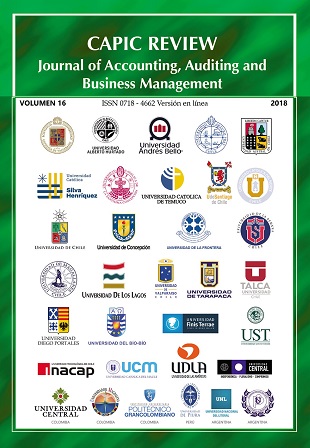Assessment of the benefit of the letter c, article 14 ter of the income tax law
Published 2018-12-26
Keywords
- Tax Benefict,
- Tax Microsimulation,
- Sme Taxpayers
How to Cite
Abstract
The present investigation establishes the effects on the total tax burden (First Category Income Tax + Complementary Global Tax) generated by SME taxpayers that accept the rules of letter C of article 14 ter of the Law on Income Taxes, establishing the nature of the differences between letter A of article 14 (14 A) or letter B of the same article (14 B) both of the Law on Income Taxes.
The qualitative paradigm methodology was used, becasuse it is expected to reflect on the nature of the differences, instead of their measurement. The investigation was describe and use a research tool of "tax microsimulation" that allowed obtaining results according to the manipulation of the variable "withdrawals" as a percentage of the tax utility.
Methodology was used according to the qualitative paradigm, because we want to reflect on the nature of the differences, beyond their measurement. A descriptive investigation was carried out and a research tool of "tax microsimulation" was used to obtain results according to the manipulation of the variable "withdrawals" as a percentage of the taxable profit. The proposed objectives evaluate the effects on the total tax burden, understood as the sum of the IRPC and the IGC (the additional tax is not considered), hoping to determine a lower tax comparatively in relation to the general regime, as well as the evaluation of the burden tributary among taxpayers under letter A and letter B of article 14 of the law of the branch.
The results obtained allow to affirm that the legislator established an incentive that is pernicious for the taxpayers 14 B in relation to the 14 A.
Downloads
References
2. Atkinson, T., Bourguignon, F., O’Donoghue, C., Sutherland, H., & Utili, F. (2002). Microsimulation of social policy in the European Union: Case study of a European minimum pension. Economica, 69(274), 229-243 The London School of Economics and Political Scienc.
3. Crocker, J. & Slemrd, J. (2005) Corporate Tax Evasion with Cost Agency. Journal of Public Economic. Obtenido de: http://www.sciencedirect.com/science/article/pii/S0047272704001537
4. Devereux, M y Griffith, R (2002) The Impact of Corporate Taxation on the Location of Capital: A Review. Swedish Economic Policy Review. 9 (2002) 79-102. Obtenido de: http://spot.colorado.edu/~utar/DevereuxGriffith.pdf
5. Duncan, A. (2002). Respuestas del empleo a cambios en la política fiscal obtenidas mediante microsimulación. In Conference Paper, Institute of Fiscal Studies, Madrid.
6. Faúndez, A y Blanco, M (2017) El Régimen de Tributación Integrado Chileno para la Microempresa y Pequeña Empresa: Desde la Perespectiva de la Equidad Tributaria Economic Analysis of Law Review. Pp 143-170. Accedido desde: https://portalrevistas.ucb.br/index.php/EALR/article/view/8152/5173
7. Gil, L (2007) Análisis de los sistemas de integración IRPF-IS para evitar la doble imposición de dividendos. Presentación en XIV Congreso de Economía Pública. Santander.
8. Graham, J; Hanlon, M y Shevlin, T (2011) Real Effects of Accounting Rules: Evidence from Multinational Firms Investment Location and Profit Repatriation Decisions. Journal of Accounting Research. Vol 49 Issue 1. Pág 137-185 March 2011. Obtenido de: http://onlinelibrary.wiley.com/doi/10.1111/j.1475-679X.2010.00395.x/full
9. Hanlon, D y Pinder, S (2007) An Empirical Investigation of Whether Australian Capital Gains Tax Reforms Influencie Individual Investor Behavior Pacific Basin Finance Journal 15(2007) 481-493. Accedida el 17 de Julio de 2014 http://www.sciencedirect.com/science/article/pii/S0927538X0700011X
10. Haufler, A. (1997) Factor Taxation, Income Distribution and Capital Market Integration. Scand. Journal of Economic 99(3), 425-446. Obtenido de: http://onlinelibrary.wiley.com/doi/10.1111/1467-9442.00072/full
11. Hernández, R; Fernández, C y Baptista, P (2010) Metodología de la Investigación. Quinta Edición. Mc Graw Hill México.
12. Holmes, S y Sunstein, C (2011) El Costo de los Derechos. Por qué la Libertad Depende de los Impuestos. Traducción al castellano. Título original The Cost of Rights. Bueno Aires: Siglo Veintiuno Editores. http://papers.ssrn.com/sol3/paper.taf?ABSTRACT_ID=94036
13. Jacobs, B & Bovenberg, A.L. (2009) Human Capital and Optimal Prositive Taxation of Capital Income. Tax Public Finance (2010) 17:451-478 DOI: 10.1007/s10797-009-9120-5. Obtenido de: http://www.springerlink.com/content/a77215x2u7458167/
14. Larraín, F. (2011) Macroeconomía para Todos. Santiago: Editorial Pearson Educación de Chile S.A.
15. Mardones, C (2010) Evaluando Reformas Tributarias en Chile con un Modelo CGE. Estudios de Economía Vol 37 N°2 Diciembre 2010. Pag. 243-284m accedido el 16 de abril de 2017 en http://www.scielo.cl/scielo.php?pid=S0718-52862010000200005&script=sci_arttext
16. Musgrave, R y Musgrave, P (1992) Hacienda Pública, Teórica y Práctica. Quinta Edición. España. Mc Graw Hill.
17. Otorna, G; Ottone, S; Ponzano, F y Scacciati, F. (2008) Labour Supply in Presence of Taxation Financing Public Services. An Experimental Approach. Journal of Economic Psychology 29 (2008) 619 – 631. Obtenido de: http://www.sciencedirect.com/science/article/pii/S0167487007000578
18. Samuelson, P (1966) Curso de Economía Moderna¸ una Descripción Analítica de la Realidad Económica. Editorial Aguilar S.A. Décima quinta edición. Madrid, España.
19. Tarifa, E. (2005) Teoría de Modelos y Simulación. Introducción a la simulación. En doc. Virtual, Facultad de Ingeniería - Universidad Nacional de Jujuy. Accedido el 16 de abril de 2017 en http://www.modeladoeningenieria.edu.ar/unj/tms/apuntes/ cp1.pdf
20. Taylor, S.J, y Bogdan. R (1987) Introducción a los métodos cualitativos de investigación La búsqueda de significados https://s3.amazonaws.com/academia.edu.documents/39626073/Taylor-Bogdan_observacion_part.pdf?AWSAccessKeyId=AKIAIWOWYYGZ2Y53UL3A&Expires=1531093047&Signature=Cv8Ta1Yxy8PAIXU4pUTiswN3OLo%3D&response-content-disposition=inline%3B%20filename%3DTaylor_Bogdan_observacion_part.pdf


































